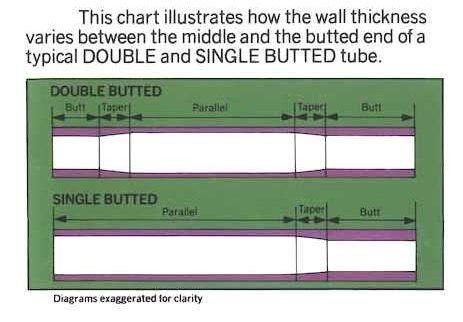Originally Posted by
Road Fan
Ok, in this website, the 1980 model year has several models labeled as "5/10" or "7/10." What do these mean?
Those numbers refer to the wall thickness of the 3 butted main tubes.
7/10 means the wall thickness in the thin non butted section is 0.7mm and the butted ends are 1.0mm thick.
5/10 is the same thing but 0.5mm thick.
Metric diameter Reynolds 531 with 5/10 wall thickness tubes were peculiar to high performance French factory frames. Peugeot and Gitane used those tubes on some of their Team and Team Replica bikes. See further explanation below.

Specs from the 1980 French Gitane catalog showing 7/10 tubing on their top 2 models that year.

Tubing wall thickness specs from the 1974
"Delong's Guide to Bicycles and Bicycling".
These numbers were accurate conversions from BWG (Birmingham Wire Gage used for pipe and tubing wall thickness) or inch dimensions. Tubes were never drawn that accurately so drop the second decimal point e.g. 1.02/0.71 = 1.0mm x 0.7mm thickness

1mm x .7mm thick butted main tubes were standard on many factory frames from as far back as the 1950's up into the 1980's, including most Peugeot PX-10s.
Relatively speaking, Columbus SP was considered "heavy gauge" tubing. But, Reynolds 531 7/10 "Sprint" tubing which was the same thickness was not - thus the myth that Reynolds was lighter than Columbus... Butted Vitus 172 was also the same 7/10 wall thickness. BTW, most Schwinn Paramounts were made of 7/10 Reynolds 531.
Those 7/10 butted tubes were still considered light weight when compared to the "gas pipe" tubing used in cheap department store bikes and also entry level bikes. They had main tubes ranging from 1.5mm to 3mm+ thick - thus the 40 lb Schwinns!
There were several reasons for using 7/10 tubing vs. thinner tubes on production frames. One, it allowed the use of less skilled workers for brazing together frames because thicker tubes were less susceptible to damage from overheating. Secondly, the thicker tubing was less likely to get damaged by rough handling during production.
Up into the 1980's many pro team bikes were made of 7/10 tubing because the heavier main tubes were more resistant to damage from crashes and rough handling by team support members.
Before riders like Hinault and Lemond came along, team riders, the domestiques, were usually issued one bike for the year. Many of those bikes were repainted and passed on for several years ending up in the hands of espoirs, young riders on training teams.
Columbus SL and Super Vitus 971 main tubes were 6/9 = .6mm x .9mm thick. The forks and stays were thinner too. Reynolds also produced tube sets with those specs. Many of the smaller builders in the UK used Reynolds 531 with 6/9 tubes plus even lighter sets with 5/8 - .5mm x .8mm top and seat tubes.
In the mid 70's the US market started getting flooded with Italian frames. Except for larger sizes most of those frames were being made of "light gauge" Columbus SL tubing.
To be continued...
verktyg
